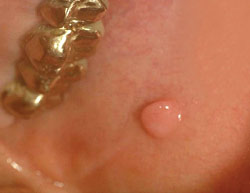Common Lumps And Bumps In The Mouth
Why it is important to have them reviewed and/or removed
Dear Doctor,
I have a small lump where I bit my cheek some months ago. It seems to get in the way and, every so often, I bite it again. My dentist sent me to an oral surgeon to have it biopsied. Is it dangerous and can you tell me more?
 |
| Photo provided by Dr. David Zegarelli |
Dear Alma,
Most likely, you are describing a traumatic fibroma (“traumatic” – injury; “fibro” – fibrous tissue; “oma” – tumor or overgrowth). It's not as bad as the name may sound and is actually quite common. Cheeks, lips and tongues occasionally get in the line of fire of the teeth and get chomped on. Most people know only too well what that feels like! Usually, these small wounds heal quickly, fully and uneventfully. But when the normal healing process is interfered with, as when the area is bitten and injured again, an excess of fibrous tissue can form.
Fibrous tissue resembles scar tissue or a callous that is composed of fibers of a protein called collagen. They actually help bind the new healing tissue together. Repeated biting or trauma to the healing tissues can cause what feels like a knot of tougher tissue, which appears as a small swelling that protrudes further and occasionally just gets in the way. With every repeated trauma, it just gets bigger and more bothersome, hence the name traumatic fibroma.
The fact that it has been there for months and is growing very slowly is an indication that the condition is chronic or long standing, and that it is most probably benign and not dangerous at all.
The easiest way to eliminate the problem is to simply have the suspected fibroma removed. A dentist with surgical training, an oral surgeon or a periodontist usually provides treatment. The area is anesthetized with local anesthesia and the lesion (abnormal tissue) completely excised (removed). Since the cheek or lip tissue is so elastic and stretchable, the wound created can be immediately and completely closed with two or three small sutures (stitches), leaving a flat and flush surface that heals in a few days to a week. There is minimal discomfort, nothing that can't be managed by non-steroidal anti-inflammatory drugs like aspirin or ibuprofen.
The excised tissue should then be biopsied. A biopsy is the removal of a sample of tissue from the body for examination. The tissue will be examined under a microscope to firmly establish that the suspected diagnosis is correct. This is a normal and routine procedure to definitively diagnose and confirm exactly what the abnormal tissue is. Biopsies are a common part of medical practice.
No one can tell for sure what the abnormal tissue growth is until it is examined under a microscope by an expert in oral pathology (“patho” – disease; “ology” – study of). Your general dentist may refer you to an oral surgeon for the biopsy. This recommended small procedure will take no more than about 10 to 15 minutes, and will be processed within days so you will know for sure what it is. In the unlikely event that it is not a fibroma, appropriate action can then be taken.
Do not fear! Follow your dentist's recommendations to obtain a proper diagnosis. Hope this helps.




